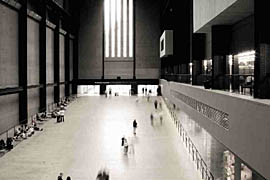
History of London's Tate: from sugar to the cathedral of modern art
 |
The two-hundred-meter-long colossus made of about 4.2 million fired bricks, Tate Modern, is just one of four galleries showcasing the Tate collections. The others are Tate Britain in the original neobaroque building on the Millbank waterfront in London, as well as Tate Liverpool and Tate St Ives in Cornwall. The entire collection has also been available online since 1998.
The gallery’s funds have grown from the original 65 donated works to a thousandfold since its opening in 1897. Today, they include works by British artists from 1500 to the present day, as well as international modern art. Among the most valuable are portraits from the time of Queen Elizabeth I, works by William Hogarth, Thomas Gainsborough, Joshua Reynolds, J. M. W. Turner, William Blake, Stanley Spencer, Henry Moore, and Francis Bacon.
And it all began with sugar. British millionaire Sir Henry Tate, founder of the London sugar refinery, offered his collection of Victorian contemporaries to the British nation in 1889 on the condition that a worthy building be constructed for it, to which he donated £80,000.
And so it happened. According to the plans of architect Sydney Smith, a noble neobaroque building was erected on the site of an old prison on the Millbank waterfront, about a kilometer upstream of the Thames from Parliament, where operations of the new gallery were ceremoniously inaugurated on July 21, 1897.
 |
The Tate family began to grow in 1988 when Tate Liverpool was built in renovated docks, which are a unique monument of technical architecture, and five years later came Tate St Ives in Cornwall.
However, the regional siblings did not make things easier for the London building, and the growing collections required additional exhibition spaces to separate the British art collection from global modernism. At the same time, only 15 percent of the enormous collection owned by the gallery, featuring 4,100 canvases, more than 50,000 prints, watercolors, or drawings, and over 1,400 sculptures, could be exhibited at one time.
The choice eventually fell on a monstrous power plant on the banks of the Thames near Tower Bridge, which had been unused since 1981, mainly due to the immense size of the building, allowing for generous usage. The original building by Sir Giles Gilbert Scott, the creator of the iconic red telephone booth, was transformed by Swiss architects Jacques Herzog and Pierre de Meuron into a temple of modern art.
During the renovation, they worked with an intensive use of glass and added two more glass-floored levels to the building, offering a beautiful view of London. At the same time, they respected the spirit of the building, preserving, for example, the 99-meter-high chimney, which could not be taller than St. Paul's Cathedral across the river when originally built.
Upon entering the building, which was ceremonially opened in May 2000, visitors are primarily amazed by the former turbine hall, which is 155 meters long and 35 meters high. Tate Modern houses international art from the 20th and 21st centuries, showcasing works by Pablo Picasso, Henri Matisse, Salvador Dalí, Jackson Pollock, and others.
The original home of the Tate Gallery on the Millbank waterfront has also been renovated, receiving the new name Tate Britain and remaining dedicated to British visual art. Entrance to all Tate galleries is free except for specialized exhibitions.
The English translation is powered by AI tool. Switch to Czech to view the original text source.










